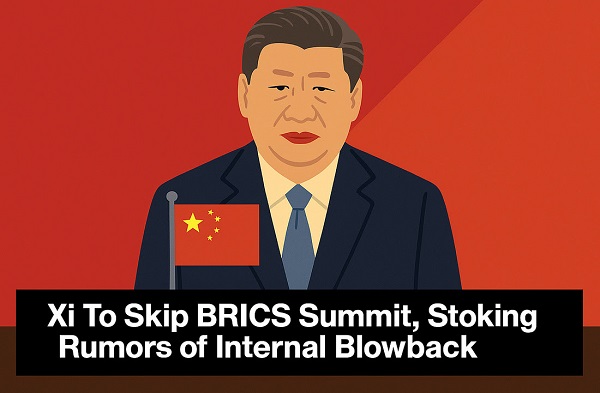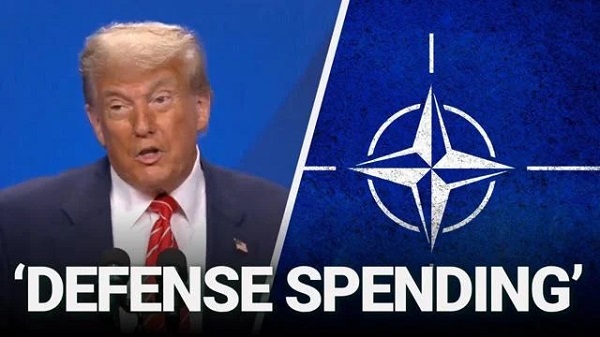conflict
China Poised To Cut Off US Military From Key Mineral As America’s Own Reserves Lay Buried Under Red Tape

 From the Daily Caller News Foundation
From the Daily Caller News Foundation
By Nick Pope
China is planning to restrict exports of a key mineral needed to make weapons while a U.S. company that could be reducing America’s reliance on foreign suppliers is languishing in red tape, energy experts told the Daily Caller News Foundation.
The Chinese government announced on August 15 that it will restrict exports of antimony, a critical mineral that dominates the production of weapons globally and is essential for producing equipment like munitions, night vision goggles and bullets that are essential to national security, according to the Center for Strategic and International Studies (CSIS). Perpetua Resources, an American mining company, has been navigating red tape for years to develop a mine in Valley County, Idaho, that could decrease reliance on the Chinese supply of antimony, but the slow permitting process is getting in the way, energy experts told the DCNF.
It can take years to secure all the necessary approvals and permits to develop a mine like the one Perpetua Resources is trying to operate. One of the key permitting laws in place is the National Environmental Policy Act (NEPA), which also applies to federal land management actions and the construction of certain public infrastructure projects like highways.
“After six years of planning and early engagement, we began the [NEPA] permitting process in 2016. We are now eight years into NEPA,” a Perpetua Resources spokesperson told the DCNF. The company is hoping to extract antimony from the largest known deposit in the U.S., and Perpetua Resources’ development could also produce millions of ounces of gold as well.
Diana Furchtgott-Roth, director of the Heritage Foundation’s Center for Energy, Climate and Environment, argues that the Perpetua Resources mine poses real environmental considerations that should be addressed, but production in the U.S. is almost certainly cleaner than production that takes place in China. Moreover, depending on China for raw materials needed to produce key defense equipment poses a clear national security risk, Furchtgott-Roth said.
“The United States has the highest environmental standards in the world for its mines, as well as for some other things, too,” Furchtgott-Roth told the DCNF. “It’s a huge national security risk. Given what we’ve seen with Russia cutting off supplies of natural gas to Europe, we know that countries can cut off important supplies to other countries.”
“If the administration wants to pursue policies that push electric vehicles, green energy and other mineral-intensive technologies, it should look to streamline the permitting process across the board rather than selectively pursuing reform for some favored types of development and not for others,” Furchtgott-Roth added.
Steve Coonen, a former Department of Defense (DOD) official who focused on technology exports to China, agreed that relying on China for raw materials needed to produce crucial technologies presents a clear national security risk.
“The United States has all the rare earth elements it needs, not too dissimilar from its energy requirements,” Coonen told the DCNF. “However, Democrats have enchained U.S. industry by prohibiting the extraction of these materials for misplaced and ill-informed ecological reasons at a significant risk to national security and the United States’ long-term economic health.”
China is responsible for just under 50% of the world’s antimony production, and it is also the source of 63% of the U.S.’ current antimony imports, according to CSIS. The U.S., meanwhile, did not mine any “marketable” antimony in 2023, according to CNBC.
China’s recently announced export restrictions for antimony will take effect on Sept. 15, according to CNBC. To many in the industry, China moving to curb antimony exports would have come as a surprise just a few months ago, so the country’s decision to take action comes across as “quite confrontational in that regard,” Lewis Black, CEO of Canadian mining company Almonty Industries, told the outlet.
In addition to antimony, China has also flexed its muscles by restricting exports of other critical minerals that it dominates globally, like germanium and gallium, since 2023.
“The United States has some of the highest permitting standards in the world, and that’s something to be proud of. But NEPA gets criticism for being inefficient, and much of that criticism is justified,” the Perpetua Resources spokesperson told the DCNF. “When we are talking about minerals we need for America’s national and economic security — not to mention our clean energy future — we need an efficient regulatory process that still maintains robust protections for communities and the environment.”
The company is anticipating that the process — from initial deposit identification to the beginning of mineral extraction from the mine site — will take 18 years, the Perpetua Resources spokesperson told the DCNF. However, the spokesperson added that NEPA has been beneficial for transparency with the public and allowing stakeholder communities to weigh in about the project.
Nevertheless, Perpetua Resources “absolutely supports a commonsense, bipartisan approach to permitting reform” because “good projects should not wither in red tape.”
The antimony curbs may be even more pressing given existing concerns about the strength of America’s defense-industrial base amid wars in the Middle East and Europe, as well as rising tensions with China over Taiwan. Many experts have cautioned that the U.S. is allowing itself to become too dependent on an adversarial China’s mineral supplies at a time when those minerals are playing a much larger role in the American economy, thanks in part to the Biden administration’s massive green energy agenda.
“In the mid-twentieth century, domestic mining accounted for 90% of the U.S.’s antimony consumption. Today, the U.S. no longer mines antimony; instead, it relies on China, its chief geopolitical rival, for over 60% of its antimony imports,” Quill Robinson, an associate fellow in CSIS’ Energy Security and Climate Change Program, told the DCNF. “Effective China de-risking requires reducing reliance up and down the value chain.”
Independent West Virginia Sen. Joe Manchin and Republican Wyoming Sen. John Barrasso teamed up to introduce a major permitting reform bill in July, designing the package to simplify the regulatory hurdles that major infrastructure and development projects must clear and expedite timelines without totally defanging regulators’ ability to ensure that environmental concerns and considerations are addressed. That bill has not yet come up for a vote in the Senate.
“There are legitimate environmental challenges that need to be mitigated for projects like this,” Arnab Datta, the Institute for Progress’ director of infrastructure policy, told the DCNF. However, government agencies are more strongly incentivized to avoid legal challenges of their reviews from third parties than they are to thoroughly review the more significant environmental concerns, meaning that regulators tend to chew up lots of time on those minor points and ultimately extend the timelines for permitting, Datta explained.
“The uncertainty from permitting and litigation compounds the challenge of reaching production in what’s often a volatile and uncertain market environment for these commodities,” Datta, who also works for Employ America as a managing director of policy implementation, continued. “These companies need a process with certainty and reasonable timelines and also support that helps mitigate the volatility that arises from China’s actions in the market.”
Featured Image: Photo by Dominik Vanyi on Unsplash
conflict
Obama Dropped Over 26K Bombs Without Congressional Approval
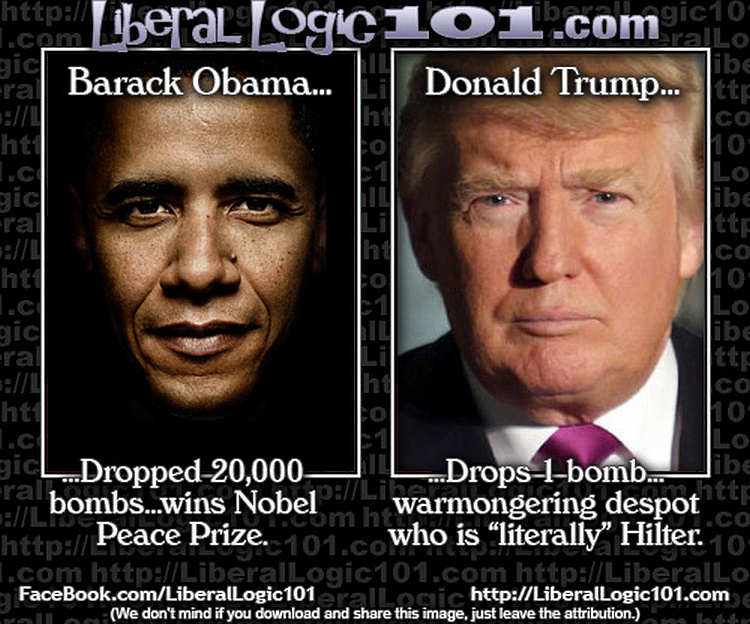
@miss_stacey_ Biden, Clinton, Obama & Harris on Iran #biden #clinton #obama #harris #trump #iran #nuclear
Iran has been the target for decades. Biden, Harris, and Clinton—all the Democrats have said that they would attack Iran if given the opportunity. It appears that Donald Trump is attempting to mitigate a potentially irresolvable situation. As he bluntly told reporters: We basically — we have two countries that have been fighting so long and so hard that they don’t know what the f‑‑‑ they’re doing.”
A portion of the nation believes Trump acted like a dictator by attacking Iran without Congressional approval. I explained how former President Barack Obama decimated the War Powers Resolution Act when he decided Libya was overdue for a regime change. The War Powers Act, or War Powers Resolution of 1973, grants the POTUS the ability to send American troops into battle if Congress receives a 48-hour notice. The stipulation here is that troops cannot remain in battle for over 60 days unless Congress authorizes a declaration of war. Congress could also remove US forces at any time by passing a resolution.
Libya is one of seven nations that Obama bombed without Congressional approval, yet no one remembers him as a wartime president, as the United States was not technically at war. Over 26,000 bombs were deployed across 7 nations under his command in 2016 alone. Libya, Afghanistan, Syria, Yemen, Somalia, Iraq, and Pakistan were attacked without a single vote. Donald Trump’s recent orders saw 36 bombs deployed in Iran.
The majority of those bombings happened in Syria, Libya, and Iraq under the premise of targeting extremist groups like ISIS. Drone strikes were carried out across Somalia, Yemen, and Pakistan as the Obama Administration accused those nations of hosting al-Qaeda affiliated groups. Coincidentally, USAID was also providing funding to those groups.
The 2001 Authorization for Use of Military Force (AUMF) was initially implemented to hunt down the Taliban and al-Qaeda after the 9/11 terrorist attacks. Obama broadened his interpretation of the AUMF and incorporated newly formed militant groups that were allegedly expanding across the entire Middle East. The Bureau of Investigative Journalism believes there were up to 1,100 civilian casualties in Pakistan, Yemen, and Somalia. Thousands of civilians died in Syria and Iraq but the death toll was never calculated. At least 100 innocent people died in the 2016 attacks in Afghanistan alone.
The government will always augment the law for their personal agenda. The War Powers Resolution was ignored and the AUMF was altered. Congress was, however, successful in preventing Obama from putting US troops on the ground and fighting a full-scale war. In 2013, Obama sought congressional approval for military action in Syria but was denied. Obama again attempted to deploy troops in 2015 but was denied. Congress has to redraft the AUMF to specifically prevent Obama from deploying troops in the Middle East. “The authorization… does not authorize the use of the United States Armed Forces on the ground in Syria for the purpose of combat operations.” Obama attempted to redraft the AUMF on his own by insisting he would prohibit “enduring offensive ground combat operations” or long-term deployment of troops. He was met with bipartisan disapproval as both sides believed he was attempting to drag the United States into another unnecessary war.
The United States should not be involved in any of these battles, but here we are. Those living in fear that Donald Trump is a dictator fail to recognize that past leadership had every intention of sending American men and women into battle unilaterally without a single vote cast.
conflict
The Oil Price Spike That Didn’t Happen


From the Daily Caller News Foundation
By David Blackmon
What if they gave an oil price spike and nobody came? That is admittedly kind of a lame play on an old saying about parties, but it’s exactly what has happened over the two weeks since June 12, when Israel launched its initial assault on Iran.
At that day’s close of trading, the domestic U.S. WTI price sat at $68.04 per barrel. As of this writing on June 24, the price stands at $64.50. That’s not just the absence of a price spike, it is the opposite of one, a drop of 5% in just two weeks.
So, what happened? Why didn’t crude prices spike significantly? For such a seemingly complex trading market that is impacted daily by a broad variety of factors, the answer here is surprisingly simple, boiling down to just two key factors.
Dear Readers:
As a nonprofit, we are dependent on the generosity of our readers.
Please consider making a small donation of any amount here.
Thank you!
- Neither Israel nor the United States made an effort to target Iran’s refining or export infrastructures.
- Despite some tepid, sporadic saber rattling by Iranian officials, they mounted no real effort to block the flow of crude tankers through the region’s critical choke point, the Strait of Hormuz.
Hitting Iran’s infrastructure could have taken its substantial crude exports – which the International Energy Agency estimates to be 1.7 million barrels per day – off the global market, a big hit. Shutting down the Strait of Hormuz, through which about 20% of global crude supplies flow every day, would have been a much bigger hit, one that would have set prices on an upward spiral.
But the oil kept flowing, muting the few comparatively small increases in prices which did come about.
Respected analyst David Ramsden-Wood, writing at his “HotTakeOfTheDay” Substack newsletter, summed it up quite well. “Oil is still structurally bearish. U.S. producers are in PR mode—talking up ‘Drill, baby, drill’ while actually slowing down. Capex is flat to declining. Rig counts are down. Shareholders want returns, not growth. So we’re left with this: Tension in the Middle East, no supply impact, and U.S. production that’s quietly rolling over. Oil shrugged.”
There was a time, as recently as 10 years ago, when crude prices would have no doubt rocketed skywards at the news of both the commencement of Israel’s initial June 12 assault on Iran’s military and political targets and of last Saturday’s U.S. bombing operation. In those days, we could have expected crude prices to go as high as $100 per barrel or even higher. Markets used to really react to the “tension in the Middle East” to which Ramsden-Wood refers, in large part, because they had no real way to parse through all the uncertainties such events might create.
Now it’s different. Things have changed. The rise of machine learning, AI and other technological and communications advancements has played a major role.
In the past, a lack of real-time information during any rise in Middle East tensions left traders in the dark for some period of time – often extended periods – about potential impacts on production in the world’s biggest oil producing region. But that is no longer the case. Traders can now gauge potential impacts almost immediately.
That was especially true throughout this most recent upset, due to President Donald Trump’s transparency about everything that was taking place. You were able to know exactly what the U.S. was planning to do or had done just by regularly pressing the “refresh” button at Trump’s Truth Social feed.
Tim Stewart, President of the D.C.-based U.S. Oil and Gas Association, has a term for this. “The Markets are becoming much better at building the ‘47 Variable’ into their short-term models,” he said in an email. “This is not a Republican Administration – it is a Disrupter Administration and disruption happens both ways, so the old playbooks just don’t apply anymore. Traders are taking into account a President who means what he says, and it is best to plan for it.”
Add to all that the reality that a high percentage of crude trading is now conducted via automated, AI-controlled programs, and few trades are any longer made in the dark.
Thus, the world saw a price spike which, despite being widely predicted by many smart people, didn’t happen, and the reasons why are pretty simple.
David Blackmon is an energy writer and consultant based in Texas. He spent 40 years in the oil and gas business, where he specialized in public policy and communications.
(Featured Image Media Credit: Screen Capture/PBS NewsHour)
-

 Crime2 days ago
Crime2 days agoSuspected ambush leaves two firefighters dead in Idaho
-

 Business2 days ago
Business2 days agoMassive government child-care plan wreaking havoc across Ontario
-

 Alberta1 day ago
Alberta1 day agoAlberta judge sides with LGBT activists, allows ‘gender transitions’ for kids to continue
-
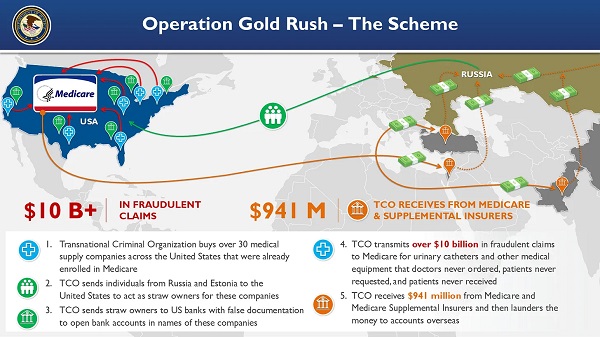
 Crime23 hours ago
Crime23 hours agoNational Health Care Fraud Takedown Results in 324 Defendants Charged in Connection with Over $14.6 Billion in Alleged Fraud
-

 Health22 hours ago
Health22 hours agoRFK Jr. Unloads Disturbing Vaccine Secrets on Tucker—And Surprises Everyone on Trump
-
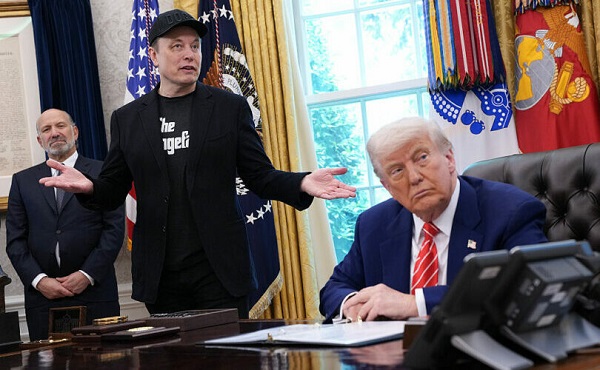
 Business11 hours ago
Business11 hours agoElon Musk slams Trump’s ‘Big Beautiful Bill,’ calls for new political party
-

 Business2 days ago
Business2 days agoCanada Caves: Carney ditches digital services tax after criticism from Trump
-

 Bruce Dowbiggin2 days ago
Bruce Dowbiggin2 days agoThe Game That Let Canadians Forgive The Liberals — Again


